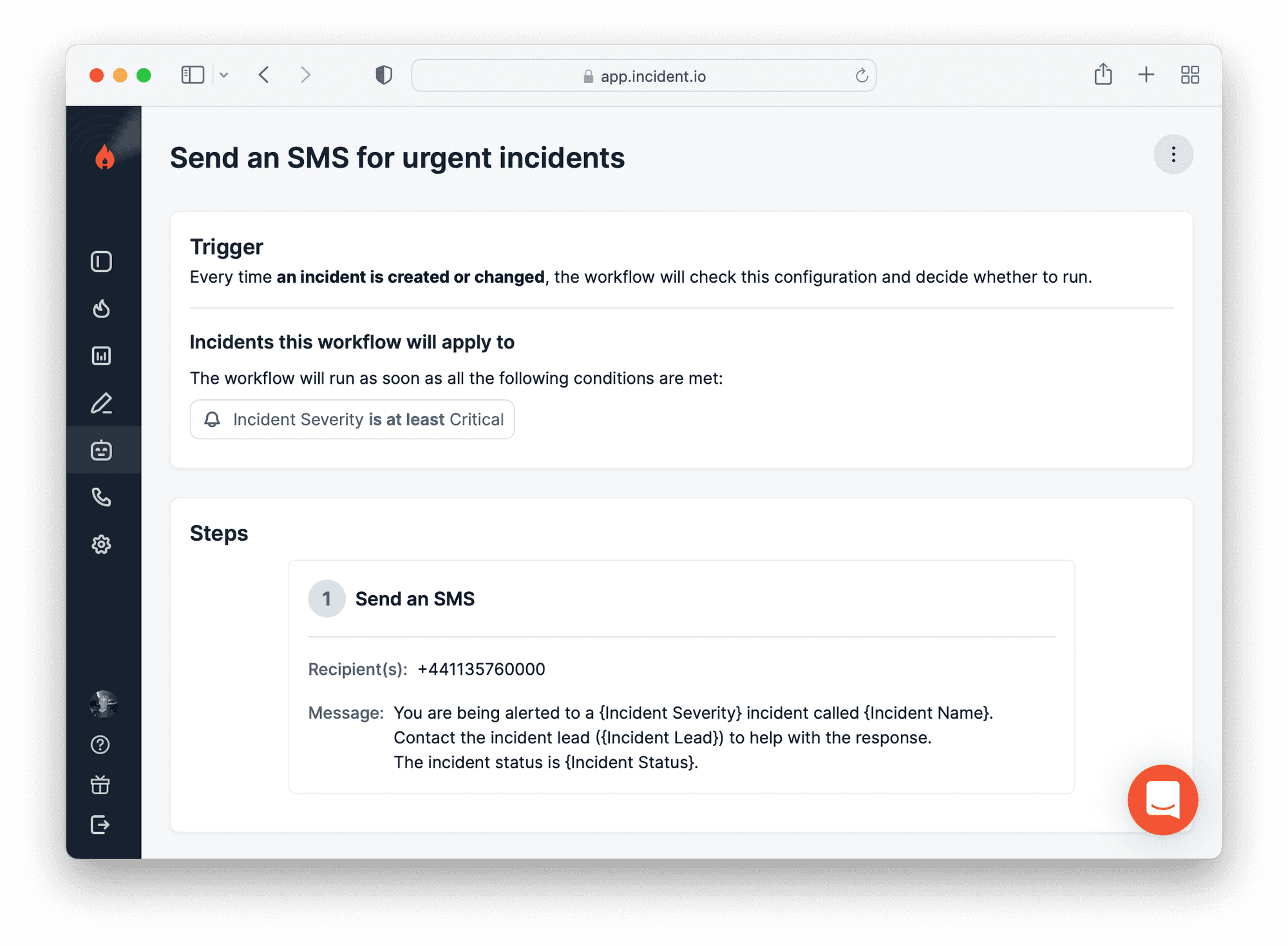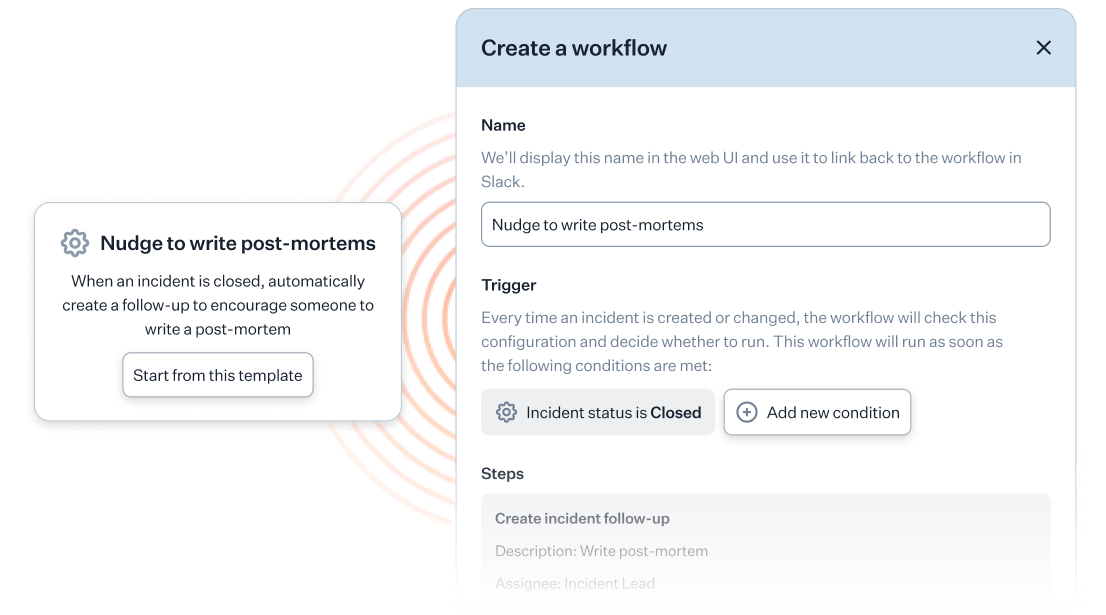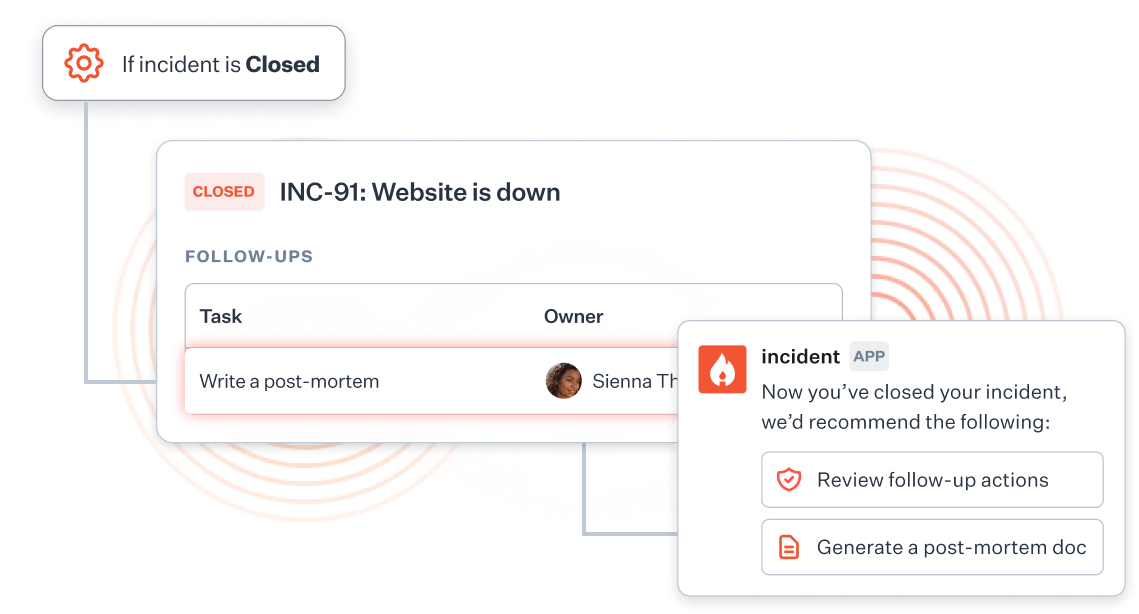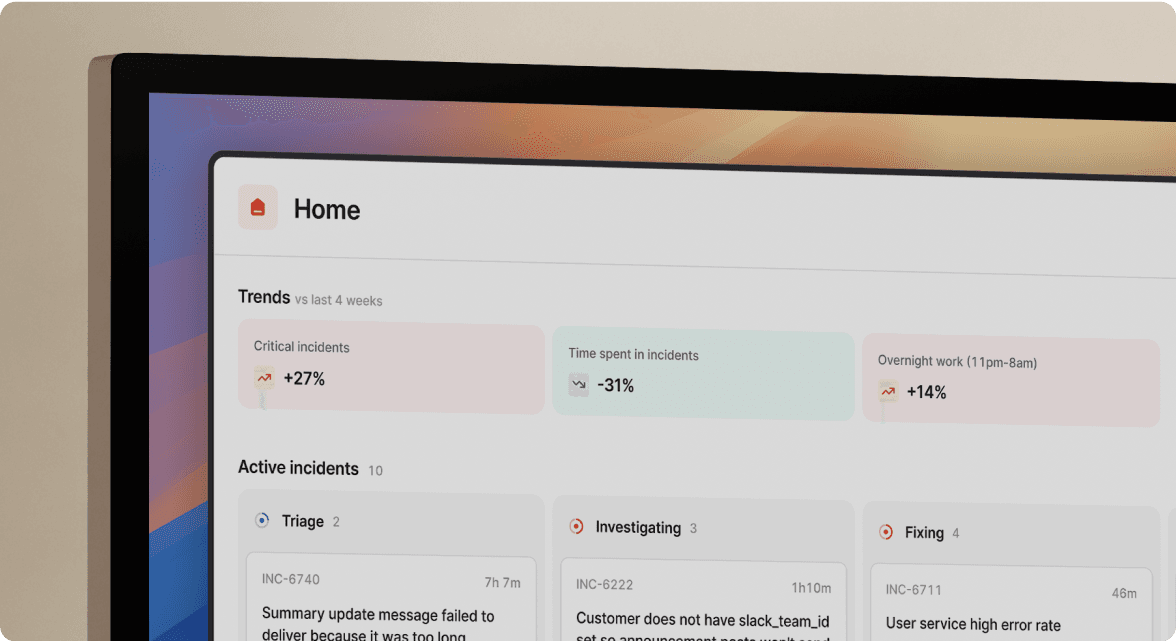incident.io Workflows: bringing automation into your incident response process

Automation is everything. At least, this is the direction the world is headed with recent advancements in AI technology. Take the raging success of GPT-4 as a prime example.
Despite its shortcomings, many consumers and businesses now rely on automation to help them with tasks that took them much longer before the introduction of AI. Coding, content creation, and even creating entire websites from a napkin sketch.
For them, help to get halfway through completing a task is worth any tradeoff, and understandably so.
Unsurprisingly, businesses are always looking for ways to speed up specific processes.
But something is getting overlooked here. Making things faster is one thing—making things better should be the ultimate goal.
So when we thought of ways to introduce automation into the incident.io product, we landed on Workflows.
But the goal wasn’t only to help folks get halfway there faster. No, we didn't want any tradeoffs. We didn't want to leave people thinking, "this is good enough. I'll take it from here."
We wanted to create an automation feature that improved businesses' incident response.
Here’s a peek at how we made that happen with Workflows.
How do we make incident response faster...and better?
This was the question at the heart of Workflows. We acknowledged that businesses want to move faster and rely on tools to help them do so.
And in many ways, our product was already helping them do exactly that.
Our interface is simple yet intuitive. The Insights dashboard gives responder teams actionable insights to improve their incident response. And communication is crystal-clear, thanks to dedicated response channels in Slack.
These features are designed to help make incident response faster, more collaborative, and more approachable.
But there was an opportunity for us to deliver much more. There was a chance to improve the incident response process even further through automation.
Here's what we focused on refining:
Improved consistency
All businesses need a sustainable, predictable, and scaleable way to respond to incidents.
Without this, there's no "right" way to respond to incidents across your organization. With no go-to incident response process, everything becomes a free-for-all. As a result, folks manage incidents in ways they feel are most appropriate.
With automation, we imagined a world where responders would be guided from one step to the next. This way, there would be no ambiguity and specific, sensible steps to follow.
- Declared an incident? Now it's time to name an incident lead.
- Closed out an incident? Remember to write up a post-mortem.
With the help of automation, consistency could become a staple of businesses' incident response.
Cut back on manual processes
Automation tools like GPT-4 help folks cut back on much of the manual work that comes with specific processes.
And while some of the individual tasks you're automating are small, you save much time in aggregate.
We envisioned this when considering how automation can help during the incident response process. With automation, businesses could cut several manual processes throughout the response process. In the end, this would add up to significant time savings.
This could look like nudging folks to email stakeholders when a high-severity incident is created. Or sending status SMS to specific teams when a certain Incident Type is created.
Again, while it feels insignificant, you'd save much time by automating these processes. And as a byproduct, you can feel confident knowing they’re getting done every time.
Focus on further improving incident resolution times
This is a huge priority for businesses.
Less downtime is the primary goal for companies adopting incident management tools. By integrating automation, businesses can lean on repeatable processes that help them respond better.
In many ways, faster response times and less downtime are a byproduct of the points above—cutting manual processes and consistent response. With automation, we could help reduce resolution times even further.
What are incident.io Workflows?
Broken down, Workflows are a collection of triggers, conditions, and steps.
X action is trigged when Y condition is met, prompting Z steps to be taken. A real-world example could look something like this:
Trigger: an incident is created
Condition: the incident is Critical
Step: an SMS is sent out to everyone on the leadership team
It's simple, but make no mistake: our Workflows feature is core to what we do here at incident.io. We wrote in-depth about the process of building Workflows here.
How do Workflows help during the incident response process?

With Workflows, we're expediting the incident response processes.
But, as we said at the beginning, automation needs to go beyond speeding things up.
With Workflows, we're also improving businesses’ incident response processes. Here's how we’re doing that:
Templated incident response processes
When it comes to incident response, there will be specific actions that you will want to do every time. But manually repeating those actions can become a considerable burden.
With Workflows, you can create templated processes that trigger whenever an action is taken. No need to do it manually.
Imagine the time you'd save if you set up a trigger that sent a status email to stakeholders whenever a Critical incident was declared.
Or if Tech Leads were added to an incident channel whenever a certain Incident Type was created, removing the chance you might forget.
With Workflows, these and much more are possible with a few clicks.
Simple nudges, just in case

Sometimes small but important things can slip through the cracks.
With Workflows, you can send responder nudges when an action hasn't been taken within a certain amount of time or after a step has been completed.
Most of the time, this will be enough to get critical actions over the finish line. Until now, the alternative would be to send a DM or email and wait for folks to respond.
With nudges, responders can be reminded that they're missing specific steps in the workspaces they're already in.
Now, you can be sure that you have a solid incident response every time and that nothing is being skipped over.
...leading to less downtime
And arguably, the most critical point is reduced downtime from incidents.
The features in Workflow establish an incident response process that's thorough. The result is less downtime from incidents.
Take this as an example:
- You create an incident of Critical severity. Workflows then adds a Tech Lead to the Slack incident channel.
- When the incident is created, an email goes out to the leadership team. This alerts them that something significant is happening.
- The Tech Lead who has been added to the channel has dealt with a similar incident, so they get to work on resolving the underlying issue.
- The incident is resolved faster because the Tech Lead was looped in automatically. The incident is then closed out.
- The incident lead gets a nudge to create a post-mortem within 24 hours since it was a Critical incident.
Without Workflows, the incident lead would have had to spend an unnecessary amount of time trying to sort out the cause of the incident, despite having someone in-house who would've been able to resolve it much faster.
Automation, with a human touch

Workflows is a game-changer in improving your incident response.
It’s simple yet highly customizable, allowing you to create automations for your specific use cases—from nudges to event triggers. For us, it’s the ideal way to use automation as an assistive tool to improve your processes.
So whether you're looking to reduce downtime, overhaul your response processes, or both, Workflows can help.
If you want to see Workflows in action, sign up for a custom demo.

See related articles
So good, you’ll break things on purpose
Ready for modern incident management? Book a call with one of our experts today.

We’d love to talk to you about
- All-in-one incident management
- Our unmatched speed of deployment
- Why we’re loved by users and easily adopted
- How we work for the whole organization



